Drifting
Flamingoes and Sonic Cranes
French
for driftwood is bois flotté but a literal translation
would be le bois de la dérive, which gave me the title
for the project La Dérive Sonore. Sonic Drift in English.
But I prefer the French, titles being notoriously hard to translate.
Are you sure there will be enough of it, I ask, I need lots, including trunk sized pieces?
Over the phone I think I see Françoise winking at colleagues Cécile and Willy. Come and have a look, I think you’ll find what you want and also a site that suits you.
Then
I start analysing the situation. I look at a map of France. Port-Saint-Louis,
deep in the Camargue, at the mouth of the Rhône, not France’s
longest river, but its deepest and most voluminous, 6km from where it
enters the Mediterranean. I follow the river back to its source, through
Lake Geneva and into the Swiss mountains. Then its major tributaries
such as the Saône which passes near where I live in Burgundy,
and others, so many of which give their names to the departments of
France - Ardèche, Isère, Doubs, Ain, Durance…. Then the
smaller rivers and streams, a vast network that covers most of eastern
France. Perhaps about a quarter of the whole country, I estimate. No
surprise then that megatons of driftwood snare up on the banks around
this place, to make it the French capital of bois flotté.
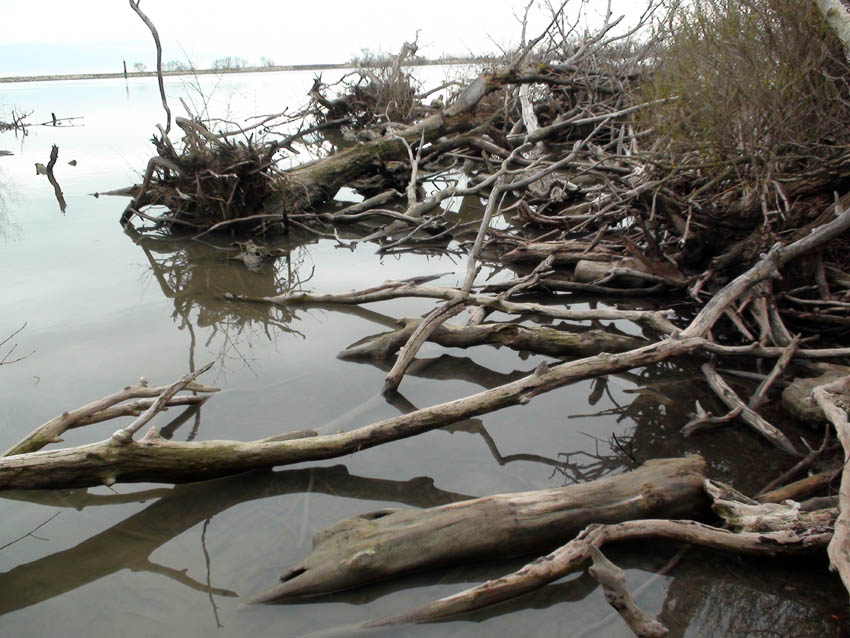
So
perhaps it’s banal to propose a project with driftwood? I ignore this
thought and start drifting. What is drift? Going with the flow, with
no fixed purpose in mind, letting the current take you. It’s not just
wood that drifts. Nearly everything does at some point, from continents
to people. He’s a bit of a drifter, we say critically, implying that
someone isn’t reaching their full potential. But what if we forget judgment
and look at the experience. I float on my back, gently approaching the
mouth of the river. The water is a little cooler than I would like,
but not unpleasant. I am far from the bank now and the current is turning
me so that my feet lead me rather than my head. My right shoulder touches
a warmer patch of water and something tickles my lower back. A piece
of reed? Air bubbles? I hear a distant engine, not sure if it’s a boat
or one of the canadair aeroplanes that scoop up water to douse fires.
Close to the bank now, the current miraculously steers me around the
curve that has already trapped many previous drifters (of the wooden
variety, and some plastic, but not human). Now I’m passing a small island
with a few cabins built on stilts around a jetty, hints of another life…
Drifting doesn’t seem so bad, perhaps it’s even the best way to start
feeling what this place is about, or what any place is about?
I ask dancer Eric and percussionist François if they’d like to
drift with me. I get excited imagining how they will respond differently
to the proposition and enrich the project - which, I should perhaps
mention, is to make an installation of sound sculptures with driftwood
in the Bois François on the banks of the Rhône.
Then to make a performance in and around the installation. Yes, they
both say immediately, and I start discussing dates. But reality soon
catches up in the form of budget cuts for the arts and I’m back to solo.
Well, not exactly. Cécile rings me. Would I like to work with
some schools groups during my residency? Ok, so long as we can work
on site and leave enough time for me to do my own work in the three
weeks I have. We settle on a structure of two classes and four sessions
with each class, half the sessions on site and half at the schools.
This part of the work becomes a duo with Cécile. She’s less of
a drifter than me. She plans and worries and imagines, and meanwhile
seems to enter effortlessly into my universe. We make a good team and
she is better at remembering the students’ names than me, while I am
good at tying pieces of string on to wood. I mention casually at some
point that I sometimes have a feeling of being about a year behind with
my work but I get things done all the same. She laughs and says she
doesn’t think she’d keep her job for long if she were a year behind…
Cécile,
and the other two I mentioned (Françoise and Willy), are part
of Citron Jaune, an arts organisation, based in the Camargue, that develops
and presents projects that take place in the street or in environmental
locations. Their flagship event since 1999 is the Envie Rhônements
Festival which invites artists from near and far to create site
specific work in the unique countryside of the Rhône delta. I
am pleased to be invited because the policy fits exactly with my own
aesthetic, doubly so because the theme this year is Ecouter le Paysage
(listen to the landscape). I reflect on my past projects and realise
that I have already made seven on the banks of - or even actually in
- the tributaries, so it feels good that I now have the chance to make
something beside the mother river, right at its mouth.

In March I choose my site, a small clearing in the woods 20 metres from
the river. There is plenty of driftwood right here but I choose to leave
it where it is as a natural enrichment of my installation, and I collect
the wood from further afield. I give myself an aesthetic rule. Just
driftwood and hemp rope or string. No cutting or shaping of wood, just
drill holes to attach strings. Retain the integrity and natural beauty
of each piece. Select the pieces both for their sound and appearance.
Reject any that fail on either count. I give the same rules to the schools
groups. I start making in April. I spend a week hanging bunches of wood
in trees as wind chimes and evolving an idea for a bigger ground-based
piece. I make a maquette for this from small branches.
Then
I get distracted by going for a walk in the marshes and lakes near the
Plage Napoléon. It is a hot and sunny Easter Monday.
A gentle wind sways the reeds around the lagoons. The famous flamingoes
are there in abundance, along with avocets and many other waders whose
names I’m not sure of. Later I see more exotic-to-me birds such as the
bee-eater and the cuckoo-jay. I’m enjoying a perfect moment. But what
if I inserted myself into this landscape and played one of my instruments,
looking for a way of playing that merges with what is already there
and, well, follows the drift? And could I share this exploration by
filming myself at the same time? Yes, I decide! So I come back the same
afternoon with my ersatzinette, which is a home-made instrument that
has accompanied me for over 20 years. It is no more than a plastic tube
with a few holes drilled in it and a saxophone mouthpiece. I choose
it in preference to my soprano saxophone for its simplicity and guttural
tone that immediately takes me away from musical traditions and in to
a direct rapport with nature. Yet it is also an instrument that is sensitive
to the expressive manipulations of breath and lip muscles that I have
learnt from many years of playing the sax. So I spend the afternoon
playing and filming myself in seven or eight different places around
these marshes. At first I limit myself to playing one note at a time,
again with the idea of fusing with nature rather than imposing on it,
like the simple call of an animal. But also because I imagine editing
the film with several layers visible and audible at once, allowing spontaneous
melodies and harmonies to emerge between the different takes. Often
I half hide myself from the camera behind some branches, or pass briefly
in view before disappearing. Sometimes I allow myself to play melodies
and more complex sound explorations, but the base is always one note
at a time for each take. The visual form emerges from the constraint
of having a fixed camera on a tripod and from being both actor and viewer.
It’s a form I am comfortable with and actually not so far from the now
ubiquitous selfie. But the film will be created in the edit.

In
one part of the lagoon a sole flamingo is fishing. I frame it in my
shot then leave the camera turning and slowly approach the water, playing
only one note on my erzatzinette. I want the bird to hear me and to
wonder what this sound is, calling to it. But of course, when I get
too near it flies off and I can’t be sure if its ears or eyes have alerted
it to my presence. Behind it in the distance are three cranes - not
the avian variety but the industrial one. The other face of the Camargue.
Tourists know the area for its birds, its wild horses, its bulls, its
lakes for extracting salt and its rice fields. But equally important,
and indeed prominent, are the heavy industrial sites of Port-Saint-Louis
and Fos-sur-Mer, big ports and home of petrochemical factories. The
cranes work away in the background - loading or unloading, I’m not close
enough to see which. I notice them but don’t give them much thought.
But then I am reminded of my first meeting with one of the teachers
I am working with on the project. I casually mention the heaviness of
the door to the room we are in and Nicolas explains that every school
in the area has a hermetically sealed room into which all the pupils
and staff must go in the case of an industrial accident. A timely reminder
not to over-romanticise this idea of fusing with nature.
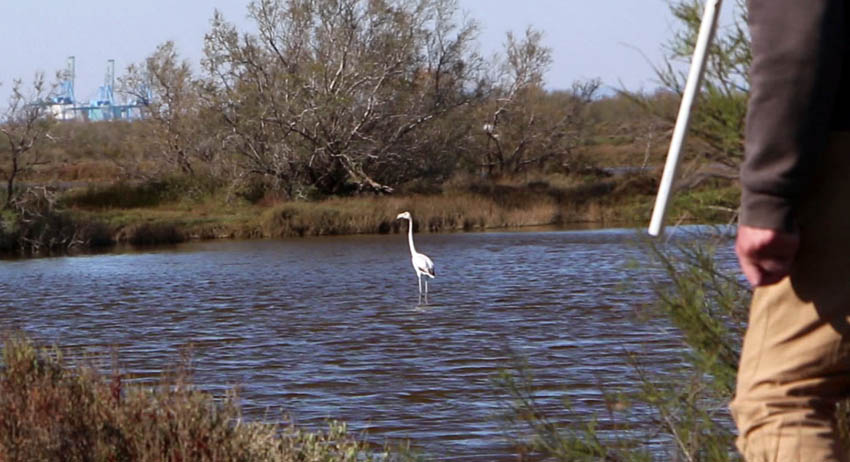
It is Cécile that provides the key to expressing this contradiction.
The evening of the day when I am filming in the marshes she takes me
to a beach much nearer to the cranes and the industrial sites, not far
from the town. We pass through a small hamlet of simple cabins and houses.
A few people are fishing from the beach and some pleasure boats are
moored nearby. The light is beautiful and, as the sun sets, the lamps
on the big ships and cranes, a couple of hundred metres across the bay,
gradually appear and transform the atmosphere. A different beauty emerges.
Perfectly calm, but from some of the chimneys unknown chemicals billow…
I resolve to return the following evening to film. Pierre, also from Citron Jaune, assists me as cameraman and is able to frame the shots more sensitively than I can if I am filming myself while playing. Luckily the light is very similar and we choose carefully the best moments and positions to film. As I play I sense movement behind me and I glance round to see an angler who wades into the sea. He casts his line and returns to the shore and waits. He knows this place well, while I am just discovering it.
By the end of the evening I am sure I have enough shots to make the
film that I am imagining. And now I know what to call it : Flamingoes
and Cranes, a title whose double meaning for once works equally in French,
Flamants et Grues.
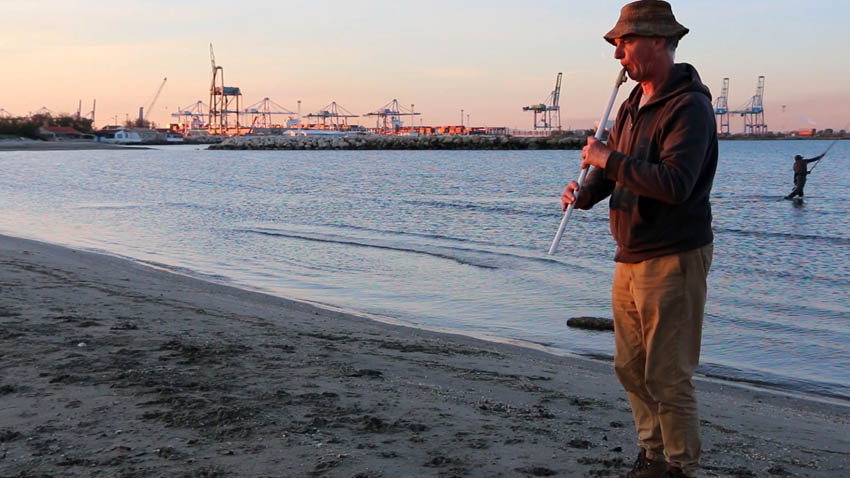
Back to my driftwood and my riverside site. I think about how I am going
to integrate some of the extraordinary bigger pieces that I have found
into my large piece on the ground, the one that I made the maquette
for. One, almost the same height as me has a beautiful spiral form that
must be from a special ornamental tree. But I decide not to feature
it, it’s better to place it alongside the others and allow the public
to discover it, or not. Its sound is no more interesting than the straighter
pieces. The richest sounds, I find, often come from the pieces with
a more oval cross-section rather than round. The note changes according
to which side you tap it on and sometimes you get surprising combinations
of two notes at once from one tap…
For many years now, part of my aesthetic for making art is the idea of resonance. Briefly, this says that the context of a piece of art is actually part of the piece itself and that the strongest pieces are those that are conceived in relation to the context. Given the right content, the context acts as an amplifier or intensifier. The most known resonance is acoustic. The transformation of a choir of human voices by the interior space of a church. The richness given to a vibrating string by the body of a violin or a guitar. But resonance can also be visual, social, historical or a combination of many things. In the end it may be a mystery and may go beyond a rational explanation of why some pieces of art seem to have an incredible intensity at certain times in certain places. I am always looking for resonance in how I make my own work. Sometimes a piece may be more resonant for me than it is for anyone else. A common problem for an artist. I spend so much time with my own work and my own perception of it in relation to past projects and my personal history that I may overlook the fact that the resonance is less present for others.
How does this affect La Dérive Sonore? Where is its resonance? Firstly, the material itself, driftwood, is something many people find beautiful and interesting. Each piece is unique, the branches’ curved forms are smoothed by the river, the colours are bleached out which gives more unity and the shapes, detached from their tree of origin, become abstract and intriguing. Who has never while out walking picked up a piece of driftwood and taken it with them? The same with a pebble or stone rounded by the sea and with a rich amalgam of colours and stripes? Simple shared pleasures.
I mentioned earlier that I decided to leave most of the driftwood that was already next to my site in place. “As a natural enrichment”, I said, but I could equally have said to make the resonance more explicit. From seeing my constructions hanging in the trees and then seeing the tangled forms of driftwood in the water it is not that big a step to then wonder where each piece of wood comes from. How far away? From what sort of tree? How did it enter the water? Did it float freely until it reached this place? Did it tangle with others? Was it worn down by stones on the river bed? Did it ever freeze up in winter? Unanswerable questions of course but stimulants to the imagination.
This group resonance I am confident of. A more personal resonance relates to another driftwood piece I made on the beach in Gaspesie, Quebec in 2008. There I used only wood that had been gnawed by beavers at both ends. On this particular beach it was easy to find hundreds of these, and what inspired me was the idea that the beavers had unknowingly co-designed the sculpture with me. This was in my mind when I collected the wood for La Dérive Sonore, and I was very happy to find amongst the wood three or four pieces with unmistakable traces of beaver gnawing. But this was a sub-plot and not the centre as it had been in Gaspesie. The main plot on this occasion is the idea that it is the river itself that is my invisible co-creator. Every tiny tributary, every drop of water that has flowed through it over a period of years has contributed to the final form of the piece. Looked at like this, La Dérive Sonore becomes an abstract portrait of the Rhône.
But
if this particular resonance is personal to me, that doesn’t bother
me, because I know too that others will bring their own personal resonances
that I know nothing about to the piece, and transform it by the different
ways in which they perceive it.

To this organic process I add geometry, acoustics and ergonomics. The
form I settle on for my main piece could be described as a double octahedron,
on a scale slightly larger than the human body. Based on the inherent
rigidity of triangular forms, it contrasts with the organic forms of
the driftwood. Strength in natural forms rarely comes from triangles,
but they important in many of my sculptures, both aesthetically and
structurally. They expose the elements of human analysis and rationality
that are always present alongside, or indeed as part of, nature. The
motivation behind my double octahedron is to make a form that is easily
entered by my own body (or yours) and allows the free vibration of some
of the larger pieces of driftwood that I have collected and then selected
for their clear sound. That’s why I say ergonomics and acoustics.
I drift again. I enter the two circles of hanging wood that my structure suspends. I push my shoulder against them and listen to their deep sounds which resound close to my ear. Then I push with my elbow, my hip, my knee - which is close to the bottom of the longer pieces. Then I close my eyes and - carefully, so as not to hurt myself - push my head against the wood. Something resounds in my stomach. Or is it my intestine? I’m not sure, but these vibrations of wood seem much deeper when in direct contact with my body. They touch me in some unknown place. This, more than anything, is the resonance that I want to share with others…
But
how? This thought gives me the first impulse to start thinking about
the performance that I am going to make with my installation as part
of the Envie Rhônements Festival at the end of July. I decide
that this will make a really good end for my performance. I will enter
the sculpture and make it sound with every part of my body. Come close
to it physically, close my eyes and lose myself in its sound. The audience
will hear the sounds, which will not be as rich as what I hear, but
they will see that I am having a strongly sensual experience and will
be curious. Afterwards, some of them will explore this experience themselves
by entering the sculpture like me and in that way will feel the resonance
with their bodies.

Meanwhile, one of the school groups have installed their own sound sculptures in another clearing not far from mine. Their works are quite similar to mine because we are working with the same materials and the same constraints, but they have come up with some different ideas too. What pleases me most is that they have really taken on the concept of working with the place and they have all incorporated trees and bushes in to their structures that make the overall installation unique and site specific. Cécile is helping one group tie their strings on and prop the piece against a tree. This is the third session with this group and I have even learnt a few of the names… Once installed each group explores the sounds of their sculpture in improvisation. Then we all come together playing simple musical games standing in a circle with hand held pieces of driftwood.
Then
more drifting. I find a large curved piece of driftwood that fits comfortably
on my shoulder. I tie ten smaller pieces to it with strings just long
enough for the wood to touch the ground. I am pleasantly surprised to
discover that I can walk with it on my shoulder without holding it.
But its weight and momentum suggest a slow walk with a particular rhythm
almost like a truncated gallop. Then I find that by bending forward
slightly and bowing my head I can turn my body in such a way that the
ensemble transfers to my other shoulder. In this way the structure is
reversed so that the sticks that were behind me are now in front. Another
element that can be developed for my performance. I give it a provisional
title Soft Shoulder, and gradually discover other ways of playing it
including bending my knees and making the wood tap on the ground or
scrape across flat stones.
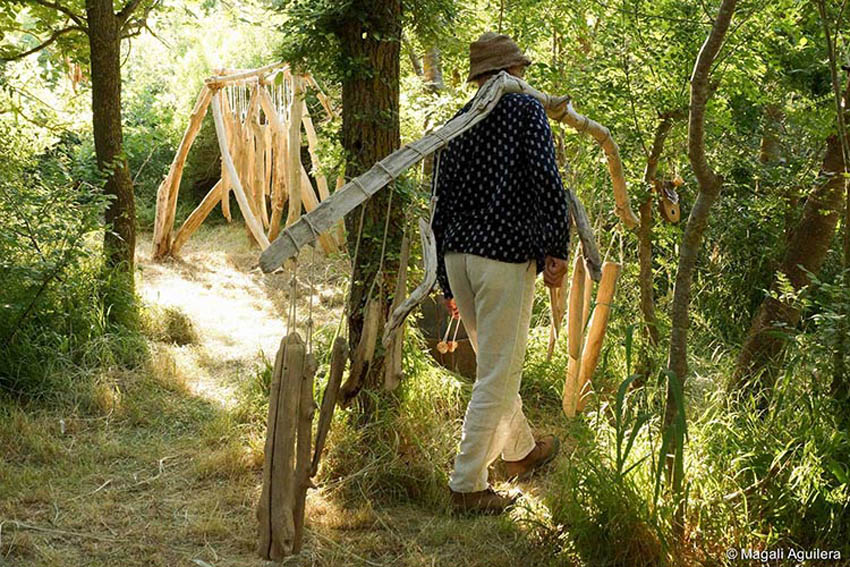
The performance when it comes feels like a good continuation of the
project, not exactly the climax but a concentration of many of the different
elements that have gone in. One strong memory is an exchange with two
local women who watch me rehearsing the day before and hear echoes of
jazz in some of the sounds I make. They say they will come to the performance,
but I don’t think they do. The strong resonant moment for them has already
happened, and that feels good to me. About 50 people do come. The clearing
is small and I am close to the spectators. I have prepared intensely
and I find it easy to enter deeply into my material - my driftwood in
its different forms and other materials I have added to make a richer
more musical performance. I enjoy the concentrated attention of the
audience and enter an almost trance like state. I feel satisfied as
the performance draws to a close with me inside the circles of hanging
wood of my double octahedron, as I had imagined two months earlier.
The reception is warm but restrained. I come out of my performance bubble
and begin to wonder if in fact I have worked too much with my personal
resonance, communing with my material but not enough with the spectators.
I wonder if they have understood that I am drifting, I have a small
sensation of not quite realising my potential… No, not my potential,
our potential. Something in the relationship has not quite
succeeded. The conundrum of drift continues. All the same, I am pleased
to see that a few people do enter inside the sculpture afterwards, as
I had hoped.
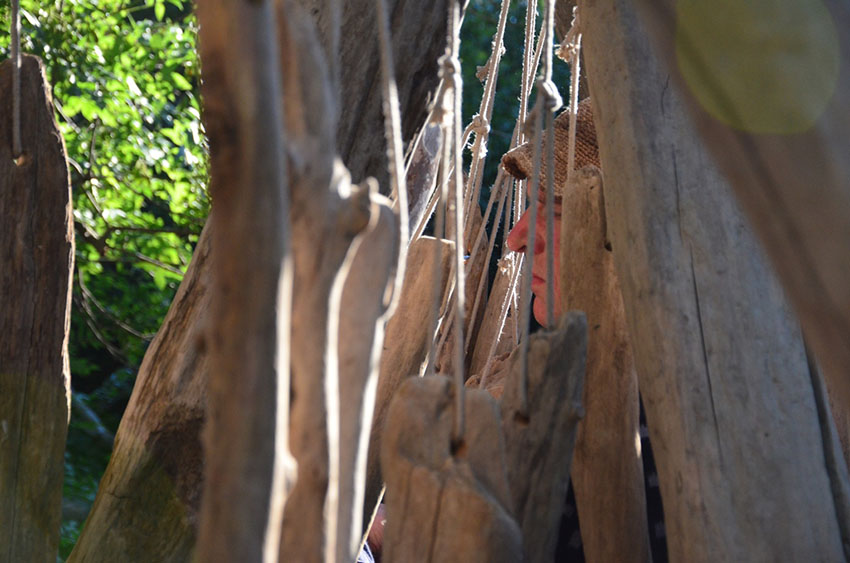
photo : pierre prétot
The
next day the festival continues and I have the opportunity to project
Flamingoes and Cranes at another site, the
Marais de Viguerat. More resonance, because the site is quite
similar to the one where I filmed, with marshes and lakes and open prairies.
I make a makeshift screen and hang it from one of my leftover pieces
of driftwood in a clump of trees. From dusk until late my film turns
in loop and the public dip in to it or stay with it for a whole cycle
as their needs dictate. Are they drifting? Do they find resonance? Not
for me to say, but the project is not over. Back at the Bois François
my installation La Dérive Sonore stays in place and I look forward
to seeing it gradually returning to nature as the wood decays and the
rope holding it together rots until it becomes indistinguishable from
the woods surrounding it, the earth under it and the water of the Rhône
beside it. Other traces remain, such as the film and this account in
words and photos. All this I consider part of the piece itself, an ensemble
of different media and a web of evolving relationships that, hopefully,
enriches lives, as art should. The traces in other people’s lives whether
minute, banal or profound I would like to be able to imagine, but it
is beyond me. Yet maybe I will find clues arriving in future months….
We’ll see.
Will Menter, September 2015
film
: flamingoes and cranes
writing by will
performances, installations, music